Ethernet Cable Gauge: 24 vs 26 vs 28 AWG
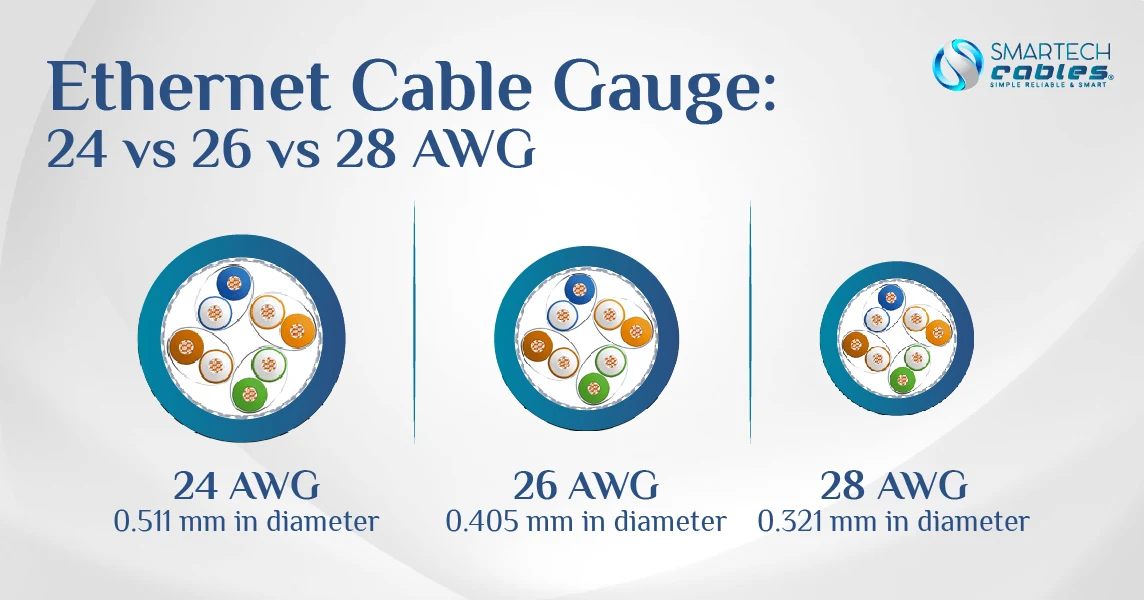
Choosing the right Ethernet cable can be tricky, especially when you come across terms like 24 AWG, 26 AWG, and 28 AWG. These numbers refer to the thickness of the cable wires and can affect your network speed and reliability. If you’ve ever wondered which gauge is better for your home or office setup, you're not alone. Picking the wrong cable might cause slow internet or connection drops, which can be frustrating when streaming, gaming, or working online.
Industry standards like TIA/EIA-568 set clear guidelines for Ethernet cables, ensuring they meet performance needs. Network performance tests show that thicker wires (lower AWG numbers) generally handle data better over longer distances but can be less flexible. Meanwhile, thinner wires are easier to manage but might not deliver the same speed or stability in all situations.
This blog will explain the differences between 24 AWG, 26 AWG, and 28 AWG cables. You’ll learn which cable suits different needs and environments to make a wise, informed choice. Keep reading to find the best Ethernet cable gauge for your setup.
What is AWG in Ethernet Cables?
American Wire Gauge (AWG) is a standardized system used to measure the diameter of electrical wires, including those found in Ethernet cables. The system works in a way that might initially seem backward: the lower the AWG number, the thicker the wire. For example, a 24 AWG wire diameter is larger than a 26 AWG wire diameter, which is larger than a 28 AWG wire.
This relationship matters because wire thickness affects several essential aspects of network performance. When looking at Ethernet cables, the AWG number typically appears on the cable jacket, letting you know what to expect regarding performance.
Here's a quick conversion of standard AWG sizes to metric measurements:
- 24 AWG = 0.0201 inches or 0.511 mm in diameter
- 26 AWG = 0.0159 inches or 0.405 mm in diameter
- 28 AWG = 0.0126 inches or 0.321 mm in diameter
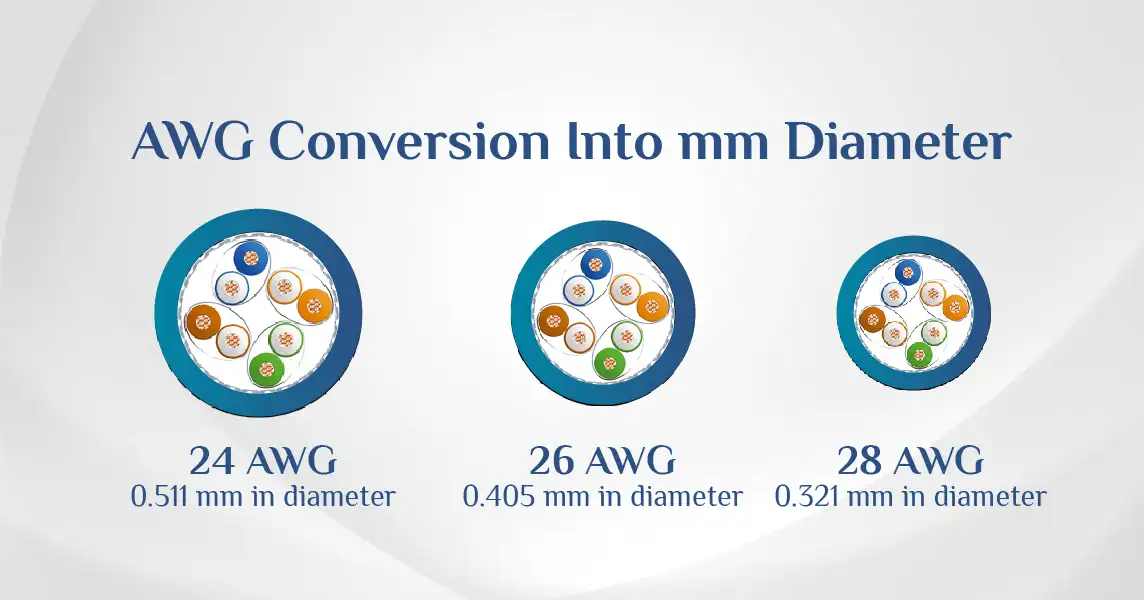
Why AWG Matters for Ethernet Cables
The gauge of wire used in your Ethernet cable affects three critical factors:
- Signal strength and quality: Thicker wires (lower AWG numbers) allow electrical signals to travel with less resistance, maintaining signal integrity over longer distances.
- Power delivery capability: For Power over Ethernet (PoE) applications like security cameras or wireless access points, thicker wires can carry more current without overheating.
- Cable flexibility and size: Thinner wires (higher AWG numbers) create more flexible, space-saving cables ideal for tight spaces.
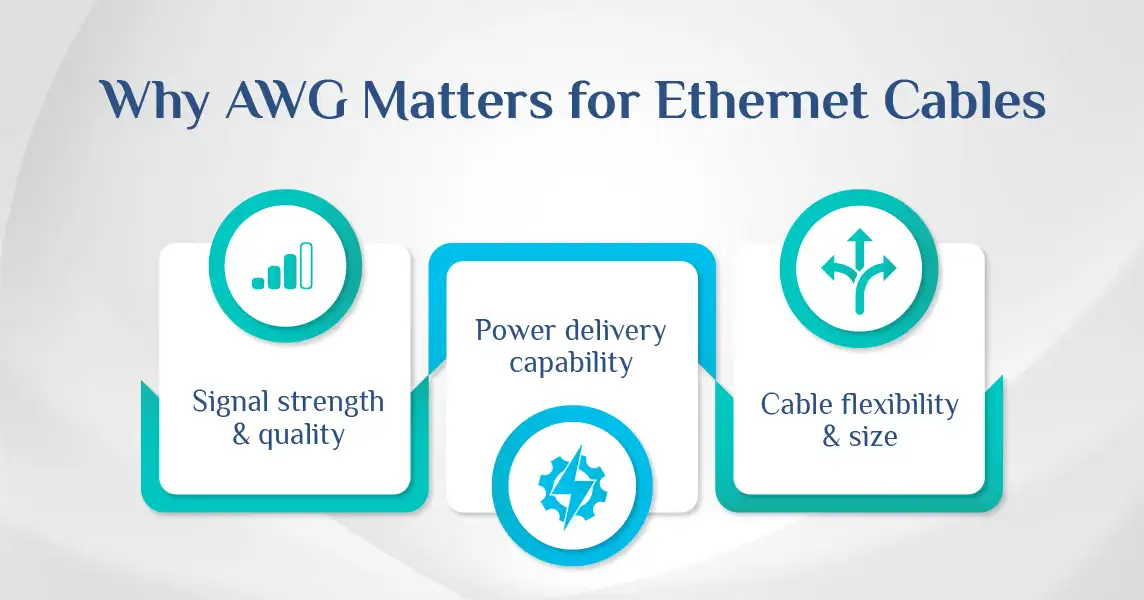
The Telecommunications Industry Association (TIA) and Electronic Industries Alliance (EIA) have established standards (TIA/EIA-568) that specify requirements for commercial network cabling, including recommendations for Ethernet wire gauge. These standards ensure reliable network performance across various applications. To learn more about how Ethernet cables impact performance, read more about different Ethernet cables affect internet speed.
Comparison of 24 AWG, 26 AWG, and 28 AWG Ethernet Cables
Let's take a closer look at the characteristics and ideal uses for each gauge.
24 AWG Ethernet Cables
24 AWG Ethernet cable represents the thickest option among the three standard gauges. These cables excel in long-distance runs, capable of reliable transmission up to the full 100-meter (328-foot) distance specified in the TIA/EIA-568 standards for Cat5e, Cat6, and Cat6a installations.
The larger conductor size of 24 AWG wire offers lower electrical resistance, which translates to less signal loss over distance. This makes bulk Cat6 cables the preferred choice for permanent installations in walls, ceilings, or underground conduits where replacement would be difficult and expensive.
However, these benefits come with tradeoffs: 24 AWG Ethernet cables are less flexible, take up more space in cable trays or conduits, and cost more than their thinner counterparts.
26 AWG Ethernet Cables
26 AWG Ethernet cable sits in the sweet spot between performance and flexibility. These cables are often used for patch cable that connect computers to wall outlets or patch panels to network switches.
Many higher-quality patch cables and some shielded Cat6 cable wire gauge specifications call for 26 AWG conductors. The 26 AWG current rating typically falls between 0.361 and 2.2 amps, making these cables suitable for standard PoE applications like IP phones and basic wireless access points.
With Cat6 ethernet cable options, 26 gauge has become increasingly popular for shorter runs where flexibility is valued but performance can't be compromised.
28 AWG Ethernet Cables
28 AWG wire represents the thinnest commonly used option for Ethernet cabling. These ultra-thin cables excel in high-density environments where space is at a premium, such as crowded server racks or network cabinets.
According to the TIA/EIA-568.2-D standard, 28 AWG Ethernet cables are limited to shorter distances—typically 15 meters (49 feet) or less—due to their higher resistance and resulting signal attenuation. However, their exceptional flexibility makes them perfect for tight spaces where traditional cables would be difficult to install.
The tradeoff comes in power delivery capabilities: 28 AWG wire ampacity is typically limited to about 0.226 to 1.4 amps, making these cables less suitable for high-power PoE applications where heat buildup could become an issue.
Key Performance Factors Affected by AWG
Understanding how different Ethernet cables affect internet speed helps you decide which cables to use in your network better.
Signal Attenuation and Transmission Distance
Signal attenuation means the loss of signal strength over distance. It is directly related to wire gauge. Thicker wires (lower AWG numbers) have less electrical resistance, resulting in less signal degradation over long runs.
This relationship becomes significant when pushing the limits of Ethernet standards or when working in environments with potential interference. For example, when comparing 24 AWG vs 26 AWG cable performance over 90 meters, the 24 AWG option typically shows noticeably less attenuation and fewer bit errors.
|
Cable Type |
24 AWG Max Distance |
26 AWG Max Distance |
28 AWG Max Distance |
|
Cat5e |
100 meters (328 ft) |
70 meters (230 ft) |
15 meters (49 ft) |
|
Cat6 |
100 meters (328 ft) |
70 meters (230 ft) |
15 meters (49 ft) |
|
Cat6a |
100 meters (328 ft) |
70 meters (230 ft) |
15 meters (49 ft) |
|
Cat7 |
100 meters (328 ft) |
70 meters (230 ft) |
15 meters (49 ft) |
Note: These distances represent generally accepted industry guidelines and may vary based on installation quality, environmental factors, and specific cable construction.
When converting from AWG to metric measurements, it's worth noting that 24 AWG to mm equals 0.511mm diameter, while 26 AWG to mm equals 0.405mm diameter. This small difference of about 0.1mm has significant performance implications over distance.
Power Over Ethernet (PoE) Capabilities
Power over Ethernet technology allows network cables to carry electrical power alongside data, eliminating the need for separate power supplies for devices like IP cameras, wireless access points, and VoIP phones. However, the wire gauge significantly impacts how much power can be safely delivered.
The 24 AWG current rating makes these cables ideal for high-power PoE applications, including IEEE 802.3at (PoE+, up to 30W) and IEEE 802.3bt (PoE++, up to 90W) standards. By contrast, 28 AWG cables may struggle with even basic PoE implementations due to their higher resistance and resulting heat generation.
|
Wire Gauge |
Max Current Rating |
Suitable for PoE Standards |
Typical Applications |
|
24 AWG |
0.577-3.5A |
802.3af/at/bt (PoE/PoE+/PoE++) |
PTZ cameras, high-power APs, digital displays |
|
26 AWG |
0.361-2.2A |
802.3af/at (PoE/PoE+) |
Standard IP cameras, wireless APs, and IP phones |
|
28 AWG |
0.226-1.4A |
Limited 802.3af (Basic PoE) |
Low-power sensors, basic IP phones |
Note: Current ratings vary based on how many conductors carry current, bundle size, and ambient temperature.
When deploying PoE systems, the 26 AWG current rating often represents the minimum practical gauge for many commercial applications. At the same time, 24 AWG provides additional headroom for future power requirements or challenging environmental conditions.
Flexibility and Installation Considerations
Cable flexibility is inversely proportional to wire thickness: cables become more flexible as the AWG number increases (and wire diameter decreases).
This relationship has practical implications for installation and cable management:
- 28 AWG: Extremely flexible, ideal for dense patch panels, tight cable management, and short connections in confined spaces
- 26 AWG: Good balance of flexibility and durability, suitable for most patch cables and connections requiring moderate bending
- 24 AWG: Stiffer construction, preferable for long, straight runs and permanent infrastructure cabling
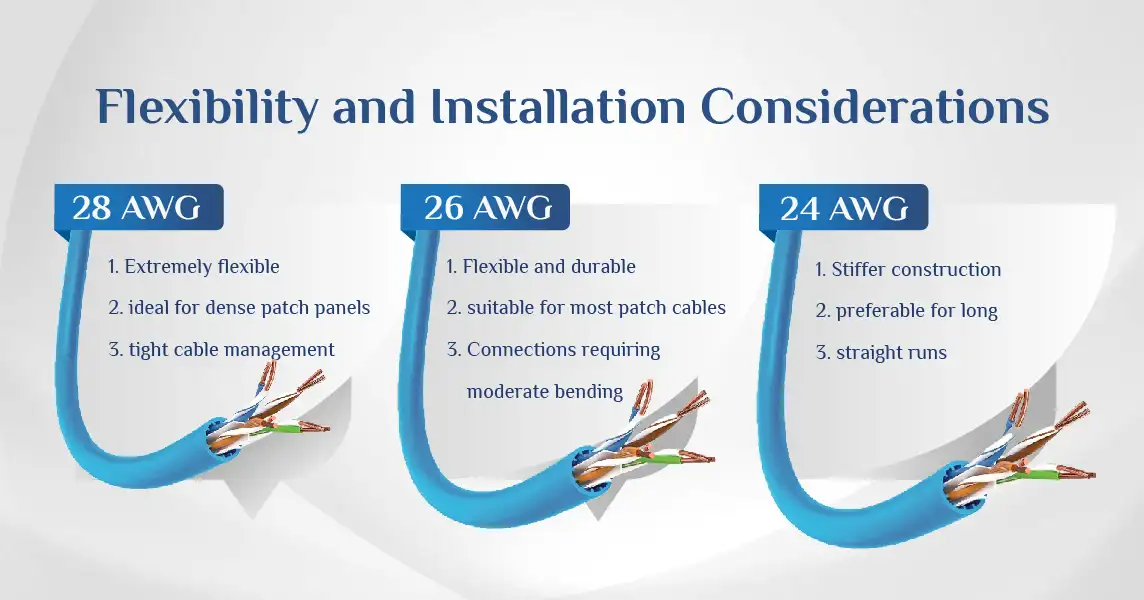
While things to consider before buying Cat6 bare copper cable include understanding that 24 gauge AWG wire provides superior electrical performance, its reduced flexibility can make installation more challenging in some environments. Conversely, 26 gauge wire offers a popular middle ground between performance and practicality for many applications.
Practical Applications for Each AWG Size
Now that we understand the technical differences between wire gauges, let's examine how they apply to real-world networking scenarios.
Home Networking with 24 AWG, 26 AWG, and 28 AWG
For home networks, the choice of Ethernet cable gauge depends on several factors, including the layout of your home, future expansion plans, and your internet speed.
For permanent in-wall installations that connect rooms throughout your home, Cat6 plenum cable provides the best performance and future-proofing. The thicker conductors ensure your network can handle high-bandwidth applications like 4K streaming or gaming with minimal latency, even over longer distances.
A Category 6 patch cord offers a good balance of performance and flexibility for connecting devices within the same room. Their manageable thickness makes them easy to route behind furniture or along baseboards without being too bulky.
28 AWG slim cables can significantly reduce cable clutter in space-constrained areas like entertainment centres with multiple devices. However, to maintain reliable performance, these connections should be kept under 15 meters.
Which Cat5e or Cat6 wire gauge to buy depends on your existing home network setup. Most permanent Cat5e installations use 24 AWG, while patch cables might be 26 AWG. If you're upgrading, Cat6 wire gauge is typically 23 or 24 AWG for best performance.
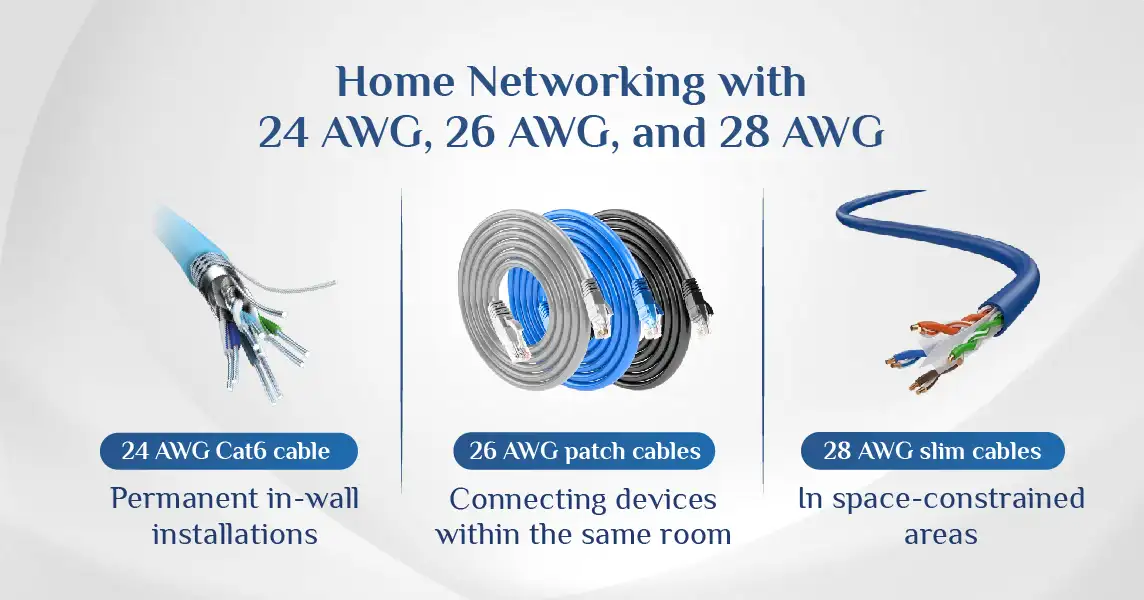
Small Business and Data Center Use Cases
In professional environments, cable gauge selection becomes even more critical due to higher performance demands and density requirements.
For small business backbone cabling, the permanent infrastructure connecting network closets and spanning between floors, 24 AWG Cat6 or Cat6a offers the reliability and performance necessary for expanding networks. This is particularly crucial when supporting multiple users, cloud applications, and VoIP systems simultaneously.
For data centres and server rooms, the needs differ based on the specific area:
- Server-to-switch connections: 28 AWG slim cables excel in high-density racks where hundreds of connections must coexist in limited space
- Cross-connects between racks: 26 AWG balanced cables provide good performance for medium-length runs
- Backbone connections: 24 AWG heavy-duty cables ensure maximum reliability for critical infrastructure
The Ethernet cable gauge you choose in these environments directly impacts network performance and cooling efficiency, as thinner cables allow for better airflow in densely packed racks.
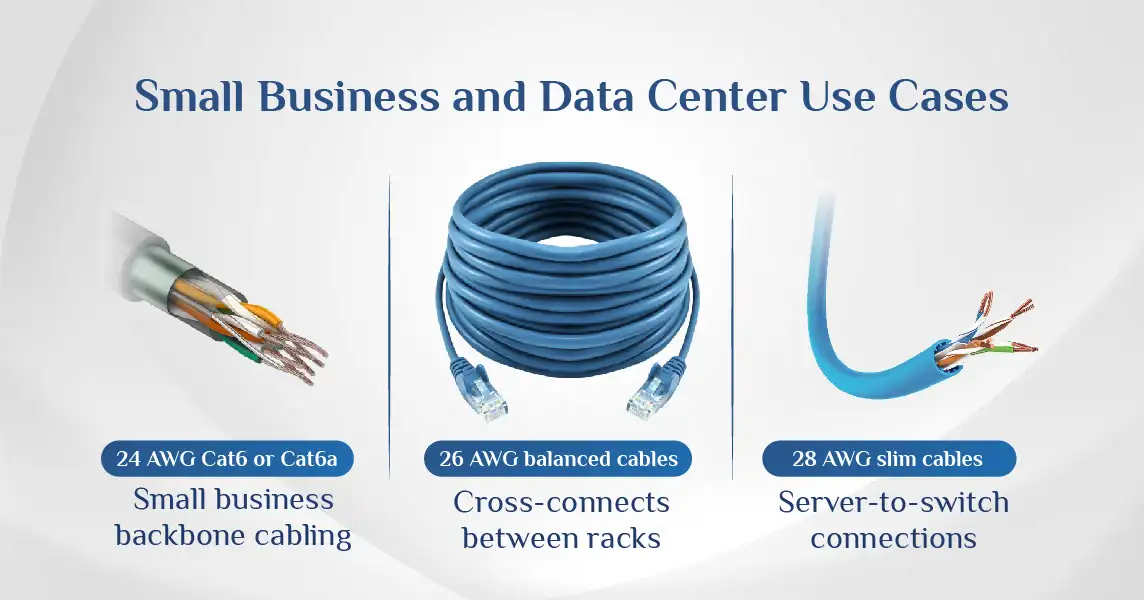
Choosing the Right AWG for Your Needs
With so many options available, how do you select the appropriate wire gauge for your specific situation?
Factors to Consider
When determining whether to use 24 AWG, 26 AWG, or 28 AWG Ethernet cables, consider these key factors:
- Distance requirements:
How long will your cable runs be?
- Less than 15 meters: Any gauge works (24, 26, or 28 AWG)
- 15-70 meters: Choose 24 or 26 AWG
- 70-100 meters: Only 24 AWG is recommended
- PoE requirements: Will
you be powering devices through the cable?
- High-power devices (PTZ cameras, advanced APs): 24 AWG
- Standard devices (basic cameras, phones): 24 or 26 AWG
- No PoE or very low power: Any gauge is suitable
- Installation environment: Where and how will the cable be installed?
- In-wall or conduit (permanent): 24 AWG
- Patch panels to switches: 26 or 28 AWG
- High-density racks: 28 AWG
- Budget considerations:
How much are you willing to spend?
- 24 AWG typically costs more than 26 AWG
- 28 AWG specialty cables often carry premium pricing despite using less copper
One common question is: "Is 24 gauge thicker than 26?" Remember that lower numbers indicate thicker wires in the AWG system. This sometimes confuses when comparing gauge vs AWG specifications.
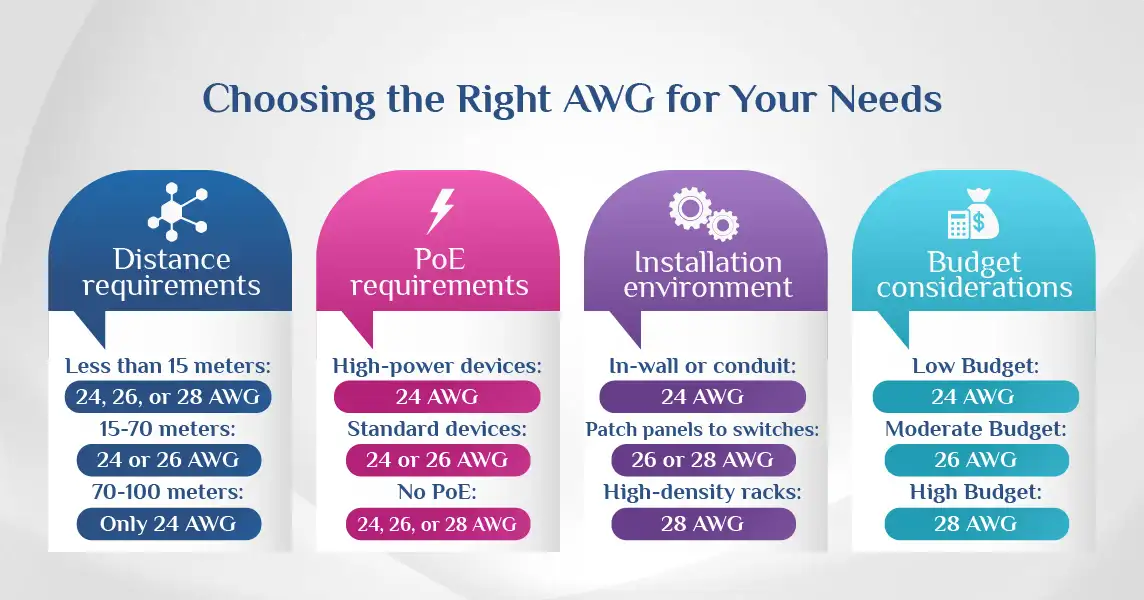
Step-by-Step Guide to Selecting Ethernet Cables
Follow this process to choose the correct cable gauge for your needs:
- Measure your required distance:
- Use a tape measure to determine the exact length needed
- Add 15-20% extra for cable management and future flexibility
- Compare your requirements against the maximum distances for each gauge
- Inventory connected devices:
- List all devices that will connect via Ethernet
- Note which ones require PoE and their power consumption
- Match the power needs to the appropriate wire gauge
- Assess your environment:
- Tight spaces may benefit from 28 AWG slim cables
- Challenging installations (outdoor, industrial) usually require 24 AWG
- Standard office environments can often use 26 AWG
- Check compliance requirements:
- Verify if your installation must meet specific TIA/EIA-568 standards
- Ensure what gauge wire is Cat5e, Cat6, or higher, based on your performance needs
- Commercial buildings often have particular requirements for permanent cabling
Future Trends in Ethernet Cable Gauges
The networking industry continues to evolve, with several emerging trends in cable gauge technology.
Emerging Standards and Technologies
The TIA/EIA-568 standards continue to evolve, with recent updates addressing the use of 28 AWG cables in commercial environments. These updates recognize the growing importance of space efficiency in modern network installations.
In high-density data centers, the trend toward 28 AWG slim cables continues to accelerate as rack densities increase. Manufacturers have responded by developing enhanced 28 AWG constructions that push beyond previous limitations.
For Cat6a vs Cat5e specifications, we're seeing innovations in cable design that maintain performance even with slightly higher gauge (thinner) wires, through improved insulation materials and conductor arrangement.
Advancements in PoE and Network Speeds
As power over Ethernet technology advances to deliver even higher wattages (up to 90W with 802.3bt), the importance of appropriate Ethernet wire gauges becomes even more critical.
Industry testing suggests that future high-power PoE standards may effectively require a Cat6 riser cable for reliable operation, especially in bundled installations where heat dissipation becomes challenging.
Meanwhile, as network speeds push beyond 10 Gbps toward 25 and 40 Gbps for desktop connections, cable quality, including proper gauge selection, will play an increasingly important role in system performance.
Conclusion
There's no one-size-fits-all answer when comparing 24 AWG vs 26 AWG vs 28 AWG Ethernet cables. Each gauge has its strengths and ideal applications:
- 24 AWG wire excels in long-distance runs, permanent installations, and high-power PoE applications where performance and reliability are paramount.
- 26 AWG wire offers a
balanced approach for medium-length runs and everyday connections, combining reasonable performance with
improved flexibility.
- 28 AWG wire shines in
high-density environments and space-constrained installations where flexibility and cable management are
critical, though only for shorter distances.
You'll optimise performance and cost-effectiveness by matching the correct gauge to your networking needs. Consider factors like run length, power requirements, and installation environment when selecting from our cable accessories and bulk Cat5e cables.
Have you installed different gauge Ethernet cables in your network? Share your experiences in the comments below!
FAQ
Q1: Is 24 AWG thicker than 26 AWG or 28 AWG?
Yes, 24 AWG is denser than both 26 AWG and 28 AWG. In the American Wire Gauge system, lower numbers indicate thicker wires. The diameter of 24 AWG wire is approximately 0.0201 inches (0.511mm), compared to 0.0159 inches (0.405mm) for 26 AWG and 0.0126 inches (0.321mm) for 28 AWG.
Q2: What gauge wire is used in Cat5e and Cat6 cables?
Most permanent Cat5e Ethernet cable and Cat6 wire gauge installations use 24 AWG solid copper conductors for optimal performance. Patch cables often use 26 AWG stranded wire for better flexibility. Some specialty Cat6 cable wire gauge may be 23 AWG for enhanced performance, while slim solutions may use 28 AWG for space-saving installations.
Q3: Can 28 AWG Ethernet cables support PoE?
28 AWG Ethernet cables can support basic PoE applications (IEEE 802.3af, up to 15.4W), but are not recommended for PoE+ or PoE++ implementations due to higher resistance and potential heat buildup. 24 AWG or 26 AWG cables are strongly recommended for higher power requirements.
Q4: How does AWG affect Ethernet cable performance?
AWG affects three main aspects of performance: signal strength over distance (attenuation), power delivery capability (important for PoE), and physical characteristics like flexibility and size. Lower AWG numbers (thicker wires) provide less signal loss over distance and better power handling, while higher AWG numbers (thinner wires) offer better flexibility and space efficiency.


